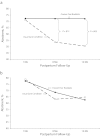Self-help booklets for preventing postpartum smoking relapse: a randomized trial
- PMID: 22994170
- PMCID: PMC3477952
- DOI: 10.2105/AJPH.2012.300653
Self-help booklets for preventing postpartum smoking relapse: a randomized trial
Abstract
Objectives: We tested a series of self-help booklets designed to prevent postpartum smoking relapse.
Methods: We recruited 700 women in months 4 through 8 of pregnancy, who quit smoking for their pregnancy. We randomized the women to receive either (1) 10 Forever Free for Baby and Me (FFB) relapse prevention booklets, mailed until 8 months postpartum, or (2) 2 existing smoking cessation materials, as a usual care control (UCC). Assessments were completed at baseline and at 1, 8, and 12 months postpartum.
Results: We received baseline questionnaires from 504 women meeting inclusion criteria. We found a main effect for treatment at 8 months, with FFB yielding higher abstinence rates (69.6%) than UCC (58.5%). Treatment effect was moderated by annual household income and age. Among lower income women (< $30 000), treatment effects were found at 8 and 12 months postpartum, with respective abstinence rates of 72.2% and 72.1% for FFB and 53.6% and 50.5% for UCC. No effects were found for higher income women.
Conclusions: Self-help booklets appeared to be efficacious and offered a low-cost modality for providing relapse-prevention assistance to low-income pregnant and postpartum women.
Figures


References
-
- US Department of Health and Human Services, Public Health Service, Centers for Disease Control, Center for Chronic Disease Prevention and Health Promotion, Office on Smoking and Health. The Health Benefits of Smoking Cessation. Atlanta, GA: US Department of Health and Human Services; 1990. DHHS Publication No (CDC) 90–8416.
-
- Centers for Disease Control and Prevention Women and smoking: a report of the Surgeon General. Executive summary. MMWR Recomm Rep. 2002;51(RR-12):1–13 - PubMed
-
- Tong VT, Jones JR, Dietz PM, D’Angelo D, Bombard JM. Trends in smoking before, during, and after pregnancy—Pregnancy Risk Assessment Monitoring System (PRAMS), United States, 31 sites, 2000-2005. MMWR Surveill Summ. 2009;58(4):1–29 - PubMed
-
- Centers for Disease Control and Prevention Smoking during pregnancy–United States, 1990-2002. MMWR Morb Mortal Wkly Rep. 2004;53(39):911–915 - PubMed
-
- US Department of Health and Human Services, Health Resources and Services Administration, Maternal and Child Health Bureau Women’s Health USA 2010. Rockville, MD: US Department of Health and Human Services; 2010
Publication types
MeSH terms
Grants and funding
LinkOut - more resources
Full Text Sources
Medical

